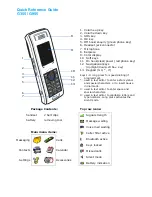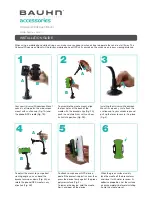
K800 - K810
1202-3085 rev. 2
FUNCTION OVERVIEW
F
U
NC
T
ION
O
V
E
R
VIE
W
DESCRIPTION
1 General
The Sony Ericsson Mobile Communication phone K800 is a 3G dual mode mobile phone
supporting WCDMA and triple band GSM/GPRS in the 900, 1800 and 1900 frequency bands. The
phone is a GPRS class 10 terminal supporting voice, circuit switched (CS) and packet switched
(PS) data. This Sony Ericsson dual mode 3G product is designed to be compatible with all
mandatory GSM phase 2+ recommendations.
The phone has an in-built antenna, a 3.2 Mega Pixel Camera with a lens cover and an associated
xenon
fl
ash, a VGA-Camera for Video Call, a Display, and a slot for a Memory Stick M2 external
memory.
There is only one size of battery. A connector at the bottom of the phone makes it possible
to connect various accessories like chargers and hands-free units. A USB cable can also be
connected to the bottom connector. The external antenna connector can be used to connect to an
external antenna, disconnecting the internal phone antenna.
The electronic functions are divided into RF parts, logic/audio parts, opto-electronic parts,
Bluetooth parts, an IR transceiver, and an FM radio. The electronics parts consists of the main
PCB with components placed on both sides, the Key-Flexible-PCB that has Key-Matrix-circuit/
LEDs, loudspeaker box with the internal antenna, ear speaker, microphone, vibrator, 3.2 mega
pixel camera, xenon
fl
ash module, VGA camera, the Display, Bluetooth module, and FM radio
parts. The RF parts are mainly housed in separate modules.
Transmitter
Receiver
Baseband
Control
DC and Return
CPU
TDMA/CDMA
DSP
AF part
Display
Keyboard
RF
Logic / audio
3,6V battery
Antenna
External connector
FM radio
Bluetooth
3.2 MPix Camera
IR
VGA Camera
Flash
Figure 1. Block diagram of the K800.
2 Transceiver
This description provides only a simple general description of the transceiver section and its
components.
2.1 Mechanical Design
The phone is built up around a core unit consisting of a plastic frame with the BT antenna
mounted on which the assembled PCB, the cameras, the vibrator, a plastic LCD holder and
the LCD, a plastic keyboard support plate and the keyboard dome foil, the loud speaker box
with loudspeaker and antenna, and the xenon
fl
ash module are mounted. This core unit is then
snapped and screwed in the front cover together with the keys, joystick, and the M2 cover. The
antenna cover with the sliding camera lens cover is then mounted. The battery
fi
ts in a dedicated
cavity and is covered with a battery cover.
Dimensions
Length
106mm
Width
47mm
Thickness
18mm (22mm across the lens cover)
Weight
115g
2.2 RF parts
2.2.1 GSM
900
The GSM 900 part of the transceiver is including E-GSM and has a frequency range spanning
from 925.2 to 959.8 MHz for the receiver, and from 880.2 to 914.8 MHz for the transmitter. This
gives 174 channels with 200kHz channel separation. The TX – RX frequency separation is always
45MHz.
2.2.2 GSM
1800
The GSM 1800 part of the transceiver has a frequency range spanning from 1805.2 to 1879.8
MHz for the receiver, and from 1710.2 to 1784.8 MHz for the transmitter. This gives 374 channels
with 200kHz channel separation. The TX – RX frequency separation is always 95MHz.
2.2.3 GSM
1900
The GSM 1900 part of the transceiver has a frequency range spanning from 1930.2 to 1989.8
MHz for the receiver, and from 1850.2 to 1909.8 MHz for the transmitter. This gives 299 channels
with 200kHz channel separation. The TX – RX frequency separation is always 80MHz.
2.2.4 WCDMA
The WCDMA part of the transceiver has a frequency range spanning from 2110 to 2170 MHz for
the receiver, and from 1920 to 1980 MHz for the transmitter. This gives 12 channels with 5MHz
channel separation. The TX – RX frequency separation is always 190MHz.
2.2.5 RF
architecture
VCXO
A voltage controlled crystal oscillator (VCXO) running at 13 MHz is used as a reference for all
frequencies generated in the transceiver.
Description
SEMC Electrical Repair Manual
3
(121)
Summary of Contents for K800
Page 122: ...www s manuals com ...




































